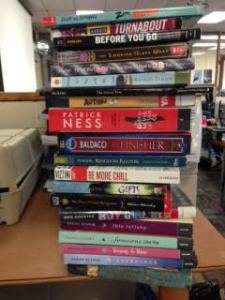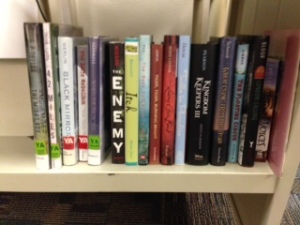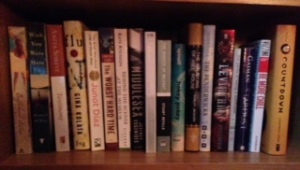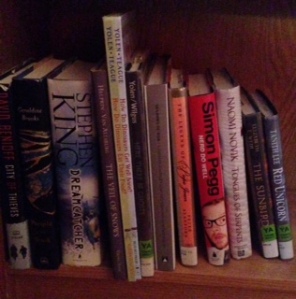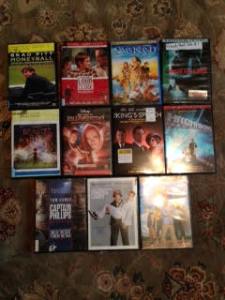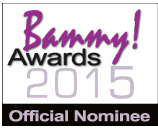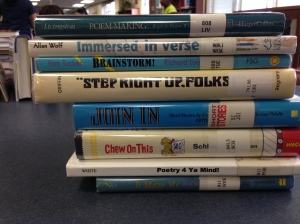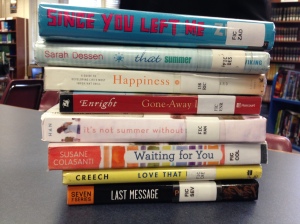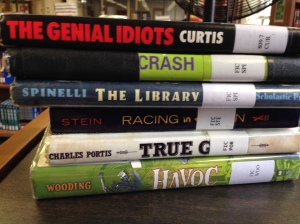I am a person of the book. Books have always been my friends, my shelters, my escapes, my filters. Along with libraries and gardens, bookstores are my favorite places, where I can easily lose hours, and am constitutionally unable to walk out without purchasing something (a trait my daughters still take full advantage of!).
In today’s society, we purport to value individuality. Yet most of our stores and restaurants are chains: monuments to continuity, comfort in familiarity. Local flavor is disappearing: you get the same food, clothes, and home decor in Atlanta as you get in Portland. There’s a freaking Banana Republic on the Champs Elysée! Online it’s even worse, because we are fed only what we already know and ‘like’, and we have to work harder than most are cognizant of or willing to do to get out of the box.
As a librarian, I’m all about choice and freedom, so I don’t judge where people get their books. But the best bookstores are the independent bookstores, which are characters and destinations in themselves. They have personality, wit, intellect, charm. Each is unique, and often specialized. Indies represent old-school individualized service that the big box stores try hard to replicate, but can’t quite provide. While indies usually stock the bestsellers, and will get you whatever’s on the latest recommended lists, they will also champion the quirky, the obscure, the local.
Indies are staffed by people of the book. They understand and cater to the needs and desires of readers. They know what we want, but even better — they know what we will love but don’t even know about yet. Not unlike librarians, indies have perfected the art of hand-selling that just right, “Goldilocks” book to the right person, and can even make or break a book or author. They also host readings, author signings, children’s programming, book clubs, writer’s groups.
The real draw of indies is experiential. The feeling that you belong, of being at home, welcomed, loved, taken care of. A languid afternoon. The hard-to-locate research resource. A Proustian memory launched upon the discovery of a forgotten childhood favorite. That chance meeting with a stranger who is a kindred spirit. Chatting up your favorite author. The literary equivalent of a bar where everyone knows your name. I want to tell you about a few that matter to me.
Harding’s Rare Books, on Route 1 in Wells, Maine, is an antiquarian bookstore. They specialize in New England history and genealogy, maps, antique prints, art and antiques. As my family’s genealogist, I find them indispensable, and have visited them almost every summer for more than a decade. They have a large space — 14 rooms, including a map room, and a room for children’s books, where my kids hang out while I pore over the file of family and town histories. Doug Harding, proprietor, has an encyclopedic knowledge of his extensive stock. My father was a collector of signed, first editions of Kenneth Roberts’ books. For years, Doug was his connection, keeping special lookout at estate sales and auctions and calling Dad whenever he found a new treasure. When my father died in 2007, Doug helped sell that collection, too. He’s family.
Food & Books, Traveler Restaurant in Union, Connecticut is my absolute favorite rest stop between home and family in Boston. Easy-on, easy-off, Exit 74, I think, off Route 84. Try the tomato soup and grilled cheese, and choose a free book off the table-side shelves that line the tables like diner jukeboxes. Or, venture downstairs to the warren of shelves filled with used books. While generally not rare or valuable, there is an extensive and well-organized collection. The best ones are shelved on the landing half-way down. I dare you to walk out without a bag full!
Books of Wonder is the mother of all children’s bookstores: THE source for new and rare/antiquarian children’s books and artwork, especially Oz books. I usually attend their YA mega-signings, and have so much fun even just waiting on line — because the bloggers, librarians, readers, & teens on line are my peeps. Once, at a signing, a woman and her tween daughter stood next to me while we all chose books to purchase. I can’t help myself. I picked up a copy of Monument 14, and started to ‘booktalk’ it, singing its praises. The woman grinned, and said “Thanks, I wrote it!” It was EMMY LAYBOURNE!!!! I was so embarrassed, but she was thrilled, because she knew my recommendation was completely honest. Owner Peter Glassman is the MAN. He knows his stuff, and gets all the best authors to come there. I saw Brian Selznick do an AWESOME presentation there about the inspiration and writing of Wonderstruck. I also attended Neil Gaiman and Adam Rex’s hilarious reading of Chu’s Day. I actually joined Twitter that day JUST so I could know when my number was called to meet Neil Gaiman.
As if you needed an excuse
The American Booksellers Association, the professional organization for indies, cites surveys and reports to make a solid case that shopping at indies is good for the economy, (local businesses reinvest in the local community), good for the environment (less traffic and pollution), and “helps other local businesses, which creates greater diversity and helps the community maintain its unique appeal.” (source). Check out their advocacy page for more information on how to support indies and why, censorship & free speech issues, programs, plus current news (including articles that might just make you swear off Amazon for good).
Supporting indies is tantamount to appreciating the value of a lifestyle we all aspire to. As people of the book, we’ve all had that fantasy to retire and run a bookstore, so we’d better keep them around ‘til we’re ready (not that most of us have any clue how hard it is). And how about financially supporting writers-to-be, who invariably work in bookstores? Did you know Brian Selznick worked at Eeyore’s Books for Children? That clerk swiping your debit card and bagging your latest picture book purchase just might be the next Caldecott Medalist! Then again, maybe he’s just a book lover trying to feed himself and his family. Aren’t we all (writers, sellers, buyers, readers) people of the book? We need each other.
Authors Love Indies
Indies support writers and the publishing industry, just as much as they support readers. It’s a symbiotic relationship that works really well, especially when personalized. In recognition of that service and support, the Raven award from Mystery Writers of America has gone to: Aunt Agatha’s, Mysterious Galaxy, Centuries & Sleuths, Once Upon a Crime, Mystery Lovers Bookshop, Kate’s Mystery Books, Mystery Loves Company, Black Orchid, and Mysterious Bookshop, to name just a few.
I asked some other people of the book you might know to name their favorite indies, too. Aside from protestations of picking favorites, authors jumped at the chance to throw some — what’s the opposite of shade? throw some sun? — at the indies they love. If you want to support authors, support their fave indies.
Kate Milford, whose terrific novel, The Greenglass House, just won the Edgar for best juvenile and reminded me of The Westing Game, touted McNally Jackson in NYC & Reading Reptile in Kansas City. Amy, a.k.a. A.S. King, came out of a self-imposed Twitter break to share her love for “Aaron’s Books in PA, Changing Hands in AZ, and Clinton Book Shop in NJ. Oh! And Children’s Book World near Philly.” Laura Ruby, whose latest book Bone Gap is EXTRAORDINARY YOU MUST READ THIS IT WILL WIN ALL THE AWARDS, chooses Anderson’s Bookshop in IL, Wild Rumpus Books & Addendum Books in MN. Barry Lyga, my daughter’s favorite author, for the I Hunt Killers series, took a moment from new daddy duties to express “special love for Changing Hands and Rivers End Books.” Patrick Carman, prolific author, including the newest Pulse trilogy, kept it local with “Book and Game in Walla Walla — my hometown bookstore!” Alexander Gordon Smith, of the infamous Escape from Furnace series, votes for BookHive in Norwich and Books of Wonder in NY!! (because that’s where he met me, of course!).
Author Andrew Smith, who keeps YA Weird and wonderful, says “Picking just one is tough!!! But my fave has to be Little Shop of Stories, in Decatur, GA. It’s a wonderful place, with the perfect atmosphere and location. The staff truly knows and loves books, and their connection to young readers in their community is tremendous. I LOVE Little Shop of Stories. Runner up: Avid Bookshop, in Athens, GA. Great people, great town, great vibe.”
Jen Bryant, who has gotten some serious award-love in the last couple of years, especially for her work with Melissa Sweet, has a place in her heart for three indies: Wellington Square Bookshop for its “signed first-editions [of] Barbara Kingsolver, Sebastian Junger and Joyce Carol Oates” and “the most charming physical space I’ve encountered in all my years of signing books”; Chester County Book Company, with “a staff that is unrivalled in their knowledge of all genres and formats and customer service that is hard to beat…(There must be book elves in the back room!)”; and Children’s Book World, because “Hannah and Heather (mother and daughter team) are walking rolodexes of titles, authors, and illustrators and their combined book-biz experience is truly amazing.”
YA author Tessa Gratton’s “favorite indie bookstore is Mysteryscape in Overland Park, KS. The owners Cheri and Acia are warm and welcoming, always ready with a recommendation and happy to discuss books. They’re primarily a mystery bookstore, but have been making an amazing effort to be welcoming to Young Adult and other Kidlit authors and books. They put on great events with class and intimacy, and reach out to the community in a variety of ways, such as being involved in local conferences, having regular Mystery Theater performances, host book clubs and writing groups nearly every weekend.”
Her Highness, the incomparable and inimitable Jane Yolen says, “Well, the four in the running are (in no special order, only that they recently hosted me and I would go back the instant they crooked a little finger) are The Blue Bunny in Dedham, MA, the Odyssey Bookshop in St. Hadley, Mass, World’s Eye in Greenfield, MA, and The Red Balloon in Minneapolis, MN. They all feature enthusiastic and knowledgeable booksellers, a commitment to their visiting authors that go above and beyond, a sense of their literary community, a huge relationship with the local schools and libraries, and imagination.”
David Lubar, author, game designer, and nascent stand-up comic, feels “fortunate to have a variety of great indies near me, including three in PA (in Bethlehem, Emmaus, and Collegeville) and the Clinton Book Shop in NJ. But my favorite indie is Children’s Book World… because they have gotten me some great school visits over the years.” David is a devout champion of indies, and writes occasionally on social media about the evils of Amazon. He makes a good case.
Kayla Farber, book reviewer and blogger over at Daily Geekette celebrates two stores, in particular. “Books of Wonder is a destination for book lovers visiting New York City. It’s a children’s bookstore that also features art, rare and antique books, and boasts some cool author visits. With authors in and out of the store frequently, don’t be surprised if you purchase a book and bring it home to find that it’s signed. My favorite memory at BoW is the Mockingjay Midnight Release Party they threw. With Suzanne Collins. The building was packed with Hunger Games fans all theorizing and getting mockingjay temporary tattoos. Brookline Booksmith is also pretty big as far as indie stores go. They have what looks like a typical bookstore on the ground floor, and then a used section downstairs. I once found a signed Jane Yolen picture book for $3 there. If you’re willing to dig, Brookline Booksmith is full of treasures. They also have wonderful signings ranging from local Boston authors to highly well-known authors. It’s a very cool place to go hang out.”
Librarian and pop-culture aficionado Sophie Brookover says “I buy from Powell’s when buying new books. They have huge selection & the best online presence of any indie I know of. If I lived in Philly, I would probably rely on Joseph Fox. [My daughter] Nell & I have subscriptions to a variety of comics series at our local comics shop, which is definitely an independent store! We go once a month to pick up Lumberjanes, My Little Pony, Ms. Marvel & others.”
The ever-dapper Bruce Hale, author of the Chet Gecko & Clark the Shark books, whom I met at the Edgar Awards a few years ago, plugs “my hometown indie, Chaucer’s Books in Santa Barbara. They really get all the details right. It’s a big, rambling space, jam-packed with books from floor to ceiling, and staffed by a knowledgeable, passionate, friendly bunch of book lovers. They’re the kind of people who can give you great recommendations in everything from Buddhist philosophy to the latest thriller. Moreover, they’re big boosters of the SB community, supporting schools and local causes.”
Cynthia Lord, author of Rules, Half A Chance, and Touch Blue, among others, praises “Children’s Book Cellar and DDG Booksellers… I love them because they love books and readers and it shines in everything they do. Both stores are warm, inviting, and full of wonder.”
Pete Hautman, truly a thinking man’s writer, said, “I’ll risk honesty & say Uncle Hugo’s in Minneapolis cuz it’s what I think a bookstore should be. Quirky and weird.” (Pete, I’m with you there, and also: remind me to talk to you about “The Walking Dead”.)
Matthew Kirby, award-winning author of Icefall, The Clockwork Three, etc., explains: “The King’s English is a Salt Lake City institution, and SO supportive of local authors. Amazing, friendly people.” Author/Illustrator and hilarious historian Nathan Hale admits his favorite indie “changes from month to month, right now: Blue Willow in Houston.” Shannon Hale, author and articulate advocate for reading without gender assumptions, concurs: “in my hometown King’s English, [and] Blue Willow rocks!”
Elizabeth Wein whom I first met at Horn Book at Simmons, then again at the Edgars, who wrote one of my FAVES of all time (and multiple award-winning), Code Name Verity, is a “huge fan of Main Street Trading Company : fantastic atmosphere & staff in MIDDLE OF NOWHERE Scottish Borders creates community, great events, plus they introduced me to my OTP Nancy Mitford. Also, a picture of my book is on their wall.”
Adult mystery author, winner of the Mary Higgins Clark award, and road warrior Jenny Milchman explains, “Bookstores are so important to me that here is what [my husband and] I did after I finally got published. We rented out our house, traded in two cars for an SUV that could handle Denver in February, took the kids out of school to “car school” them on the road, and toured the bookstores of this great country. All told, we visited about 500…. Despite some reports you may hear, the demise of bookstores has been greatly exaggerated, to paraphrase an author whose books are on the shelves of almost every one…. People love bookstores, despite–or maybe precisely because of–how virtual our world has become. There’s a value in the impromptu face to face that takes place: a bookseller saying, “Oh, I loved this book!” (Or even, “I hated it.”) No one-click convenience can duplicate it. So when my third book comes out this summer, you know where I’ll be. At a bookstore–or 300. –Jenny Milchman
Celebrations and Programs
Independent Bookstore Day. 400 bookstores around the country will host special events this Saturday, May 2. Check out NYC activities, author visits & events at bookstoredaynyc. Follow or share the fun with #bookstoredaynyc or #bookstoreday. BookRiot & The Literary Hub are sponsoring an Afterparty from 9-11:30 p.m. at The PowerHouse Arena in Brooklyn.
During the week of BookExpoAmerica, the annual ABFE Art Auction to Benefit Free Speech in Children’s Books will be held on Tuesday, May 26, from 5:30-7:30 p.m. at the Grand Hyatt in Manhattan. This year will include special artworks created to honor Judy Blume. Tickets are required. Proceeds support Kids’ Right to Read and Banned Books Week.
IndieBound (from ABA), has a bookstore locator, the IndieNext list of booksellers’ reading recommendations, including those for kids and reading groups, plus where to find signed books, and fun book-nerd gear.
Indies First is a crusade for authors, publishers and the public to support indie bookstores. On Small Business Saturday (Thanksgiving weekend), authors volunteer to “work” at independent bookstores. The campaign began in 2013 when Sherman Alexie beseeched authors to take part (read his original letter here). Daniel Handler (aka Lemony Snicket) began his own initiative for IndiesFirst in 2014: Upstream, a partnership in which authors can sign books to be stocked in indie stores. There’s a registry for authors and stores to connect, and cross-promotion is encouraged.
Do it!
A brief list of stores w/locations & links is over here. Please visit one this Saturday, for Independent Bookstore Day. But don’t let it be your only visit to an indie. Keep it going! Feel free to share your own experiences with indie bookstores in the comments.
